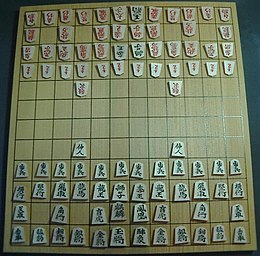Chu shogi

Chu shogi wood set. One side's pieces are all promoted (except for the unpromotable pieces), and show as red.
|
|
| Years active | Early 14th century to present |
|---|---|
| Genre(s) |
Board game Abstract strategy game |
| Players | 2 |
| Setup time | 2+ minutes |
| Playing time | 6-8 hours or more |
| Random chance | None |
| Skill(s) required | Strategy, tactics |
| Synonym(s) | Middle shogi |
Chu shogi (中将棋 chū shōgi or Middle Shogi) is a strategy board game native to Japan. It is similar to modern shogi (sometimes called Japanese chess) in its rules and gameplay. Its name means "mid-sized shogi", from a time when there were three sizes of shogi variants that were regularly being played. Chu shogi seems to have been developed in the early 14th century as a derivative of dai shogi ("large shogi"). There are earlier references, but it is not clear that they refer to the game as we now know it.
With fewer pieces than dai shogi, the game is considered more exciting, and was still commonly played in Japan in 1928–1939, especially in Kyoto. The game largely died out after World War II despite the advocacy of prominent shogi players such as Fumiaki Okazaki and Ōyama Yasuharu (who played chu shogi when young and credited it with the development of his personal cautious and tenacious shogi style). In 1976, there were about 30–40 masters of the game. It has gained some adherents in the West, and still maintains a society (the Chushogi Renmei, or Japanese Chu Shogi Association) and an online following in Japan.
The main reference work in English is the Middle Shogi Manual by George Hodges.
The objective of the game is to capture the opponent's king and, if present, the prince, which counts as a second king. These two pieces are called "royal pieces", as the game is lost when a player is left without any of them. Alternatively, under the rules of the Japanese Chu Shogi Association, it suffices to capture all the opponent's other pieces, leaving a bare king or a bare prince, whereupon the player wins and the game ends early, provided that one's own king is not immediately bared or captured on the next move. Unlike standard shogi, pieces may not be dropped back into play after capture.
Two players alternate making a move, with Black moving first. (The pieces are not differentiated by color; the traditional chess terms "Black" and "White" are only used to indicate who plays first, and to differentiate the sides during discussions of the game.) A move consists of moving a piece either to an empty square on the board or to a square occupied by an opposing piece, thus capturing that piece; and optionally of promoting the moving piece, if the move enters the promotion zone, or if it is a capture and any part of it is in the promotion zone.
...
Wikipedia
